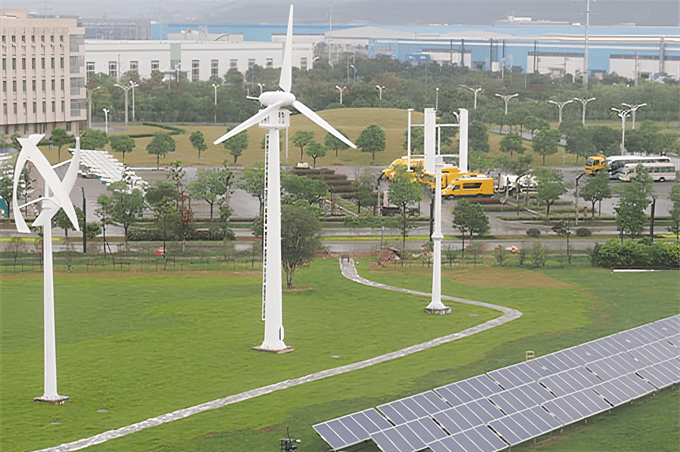Wind power, a clean and renewable energy, has significant potential. The geographical distribution of Commercial Wind Generators plays a crucial role in its development. This article examines global, regional, and national levels, analyzing wind energy resource distribution’s impact on wind power development using relevant data and case studies.
1. Global distribution of wind turbines: global pattern of wind energy resources
The distribution of global wind energy resources shows obvious regional differences, mainly concentrated in the following regions:
1.1 North America:
The United States has abundant wind energy resources, especially in the Midwest, such as Texas, Kansas, Oklahoma, etc., and the scale of wind power generation ranks among the top in the world.
Canada has vast plains, rich wind energy resources, and the wind power industry is developing rapidly.
1.2 Europe:
Europe pioneers wind power with advanced technology and a robust industry. Germany, Denmark, and the UK are key global markets, boasting top-ranking wind power generation scales.
1.3 Asia-Pacific region:
China has the world’s largest wind power market, and its wind power generation scale ranks first in the world.
China’s northern, northeastern, and northwest regions are rich in wind energy resources, and the wind power industry is developing rapidly.
India, Australia and other countries also have rich wind energy resources, and the wind power industry has broad development prospects.
1.4 Other regions:
South America, Africa, Antarctica and other regions also have rich wind energy resources, but the development of the wind power industry is relatively lagging behind.

1.5 Global wind power distribution map:
2. Regional wind turbine distribution: regional differences in wind energy resources
The richness of wind energy resources, wind speed, wind direction and other factors in different regions vary greatly, resulting in obvious regional differences in the distribution of wind turbines.
2.1 Distribution of onshore wind turbines:
Open plains, plateaus, and mountainous regions are favorable for large wind farm construction due to stable wind resources. Examples include the Midwestern plains in the US, grasslands in northern China, and the Mongolian Plateau, all ideal for onshore wind power generation.
2.2 Distribution of offshore wind turbines:
Offshore wind energy resources are abundant, with stable wind speeds and no land terrain restrictions, making them ideal for large-scale offshore wind farm construction. Key development areas include the North Sea in Europe, the eastern coast of China, and the eastern coast of the United States.
3. Distribution of national wind turbines: Development status of the wind power industry
The richness of wind resources, policy support, technical level, and economic development level of different countries vary greatly, resulting in obvious national differences in the distribution of wind turbines.
3.1 Distribution of wind turbines in China:
China has the world’s largest wind power market and ranks first in the world in terms of wind power generation scale.
The northern, northeastern, and northwestern regions of China are rich in wind energy resources, and the wind power industry is developing rapidly.
China’s wind power industry is mainly concentrated in the following provinces: Hebei, Inner Mongolia, Xinjiang, Gansu, Shandong, etc.
3.2 Distribution of wind turbines in the United States:
The US possesses abundant wind energy resources, particularly in the Midwest, including Texas, Kansas, and Oklahoma, ranking among the world’s top wind power generators. The main states driving the wind power industry in the US are Texas, California, Oklahoma, Kansas, and Iowa.
3.3 Distribution of wind turbines in Germany:
Germany is one of the earliest countries in Europe to develop wind power generation, with mature wind power generation technology and industrial chain.
The northern and eastern regions of Germany are rich in wind energy resources, and the wind power generation industry is developing rapidly.
Germany’s current wind power generation scale ranks among the top in the world.
3.4 Distribution of wind turbines in Denmark:
Denmark is a global wind power generation pioneer with a rich history of development. While land wind resources are limited, Denmark excels in offshore wind power generation. With over 50% of electricity supplied by wind power, Denmark boasts one of the highest proportions of wind power generation globally.
3.5 Distribution of wind turbines in other countries:
The UK, Spain, India, Australia, and other nations possess abundant wind energy resources, experiencing rapid growth in their wind power industries. These countries focus their wind power industry in regions with rich wind resources and robust policy support.
4. Factors affecting the distribution of wind turbines: key factors determining wind energy utilization
The distribution of wind turbines is affected by many factors, mainly including:
4.1 Wind energy resources:
Factors such as wind speed, wind direction, and wind energy density are the primary factors determining the distribution of wind turbines.
Regions with rich wind energy resources, such as plains, plateaus, mountainous areas, and coastlines, are more suitable for the construction of wind farms.
4.2 Topography:
Topography will affect the distribution and utilization of wind energy resources.
For example, mountainous terrain can form a wind outlet effect and increase wind speed, but it may also increase the difficulty of building wind farms.
4.3 Climate conditions:
Climate conditions will affect the operating efficiency of wind turbines.
For example, environments with high humidity and high salinity will accelerate the corrosion of wind turbines and affect their service life.
4.4 Grid access conditions:
Wind farms need to be connected to the grid to transmit electricity.
The better the grid access conditions, the greater the development potential of wind farms.
4.5 Policy support:
Government policy support is an important driving force for the development of the wind power industry.
Preferential policies, subsidy policies, etc. can encourage the construction and operation of wind farms.
4.6 Technical level:
The development level of wind power technology directly affects the efficiency and cost of wind turbines.
Efficient and low-cost wind power technology can promote the development of the wind power industry.
4.7 Economic development level:
The level of economic development will affect the investment scale and development speed of the wind power industry.
The higher the level of economic development, the greater the development potential of the wind power industry.
5. Future distribution trend of wind turbines: Future prospects for wind energy utilization
The future distribution trend of wind turbines will show the following characteristics:
5.1 Rapid development of offshore wind power generation:
Abundant offshore wind resources and stable wind speeds make offshore wind power a key future direction for the industry. Advancements in technology will lower costs and enhance competitiveness of offshore wind power generation.
5.2 Promotion and application of distributed wind power generation:
Distributed wind power installs turbines in residential, commercial, and educational areas for local generation and consumption. It eases grid pressure, enhances energy utilization efficiency, and optimizes energy structure.
5.3 Construction of smart wind farms:
Smart wind farms utilize big data and artificial intelligence for intelligent management and operation of wind power generation. They enhance generation efficiency, lower costs, and improve the competitiveness of wind power.
5.4 Coordinated development of wind power generation and other energy sources:
The coordinated development of wind power generation and other renewable energy sources such as solar power generation and hydropower generation can achieve energy complementarity and improve the stability of energy supply.
Building a diversified energy system can effectively respond to energy crises and ensure energy security.
6. Conclusion: Future prospects of wind turbine distribution
The distribution of wind turbines is a key factor in determining the utilization of wind energy. With the continuous advancement of wind power generation technology, the development and utilization of wind energy resources will become more extensive, and wind turbines will be distributed in more areas, providing clean and sustainable energy for mankind.





